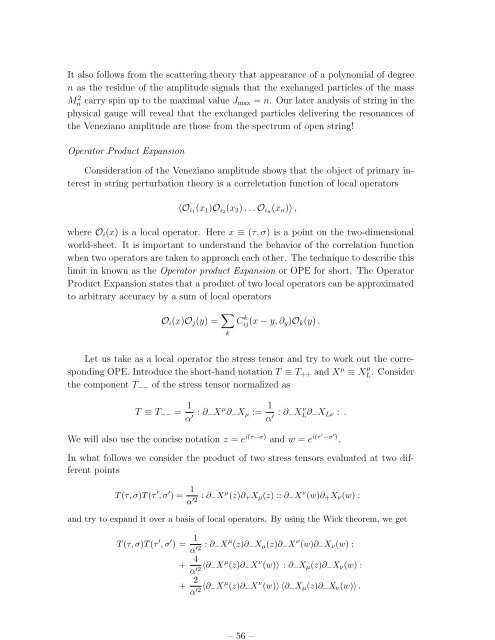Lectures on String Theory
Lectures on String Theory
Lectures on String Theory
You also want an ePaper? Increase the reach of your titles
YUMPU automatically turns print PDFs into web optimized ePapers that Google loves.
– 56 –<br />
It also follows from the scattering theory that appearance of a polynomial of degree<br />
n as the residue of the amplitude signals that the exchanged particles of the mass<br />
M 2 n carry spin up to the maximal value J max = n. Our later analysis of string in the<br />
physical gauge will reveal that the exchanged particles delivering the res<strong>on</strong>ances of<br />
the Veneziano amplitude are those from the spectrum of open string!<br />
Operator Product Expansi<strong>on</strong><br />
C<strong>on</strong>siderati<strong>on</strong> of the Veneziano amplitude shows that the object of primary interest<br />
in string perturbati<strong>on</strong> theory is a correletati<strong>on</strong> functi<strong>on</strong> of local operators<br />
〈O i1 (x 1 )O i2 (x 2 ) . . . O in (x n )〉 ,<br />
where O i (x) is a local operator. Here x ≡ (τ, σ) is a point <strong>on</strong> the two-dimensi<strong>on</strong>al<br />
world-sheet. It is important to understand the behavior of the correlati<strong>on</strong> functi<strong>on</strong><br />
when two operators are taken to approach each other. The technique to describe this<br />
limit in known as the Operator product Expansi<strong>on</strong> or OPE for short. The Operator<br />
Product Expansi<strong>on</strong> states that a product of two local operators can be approximated<br />
to arbitrary accuracy by a sum of local operators<br />
O i (x)O j (y) = ∑ k<br />
C k ij(x − y, ∂ y )O k (y) .<br />
Let us take as a local operator the stress tensor and try to work out the corresp<strong>on</strong>ding<br />
OPE. Introduce the short-hand notati<strong>on</strong> T ≡ T ++ and X µ ≡ X µ L . C<strong>on</strong>sider<br />
the comp<strong>on</strong>ent T −− of the stress tensor normalized as<br />
T ≡ T −− = 1 α ′ : ∂ − X µ ∂ − X µ := 1 α ′ : ∂ − X ν L∂ − X Lν : .<br />
We will also use the c<strong>on</strong>cise notati<strong>on</strong> z = e i(τ−σ) and w = e i(τ ′ −σ ′) .<br />
In what follows we c<strong>on</strong>sider the product of two stress tensors evaluated at two different<br />
points<br />
T (τ, σ)T (τ ′ , σ ′ ) = 1<br />
α ′2 : ∂ −X µ (z)∂ + X µ (z) :: ∂ − X ν (w)∂ + X ν (w) :<br />
and try to expand it over a basis of local operators. By using the Wick theorem, we get<br />
T (τ, σ)T (τ ′ , σ ′ ) = 1<br />
α ′2 : ∂ −X µ (z)∂ − X µ (z)∂ − X ν (w)∂ − X ν (w) :<br />
+ 4<br />
α ′2 〈∂ −X µ (z)∂ − X ν (w)〉 : ∂ − X µ (z)∂ − X ν (w) :<br />
+ 2<br />
α ′2 〈∂ −X µ (z)∂ − X ν (w)〉 〈∂ − X µ (z)∂ − X ν (w)〉 .

















